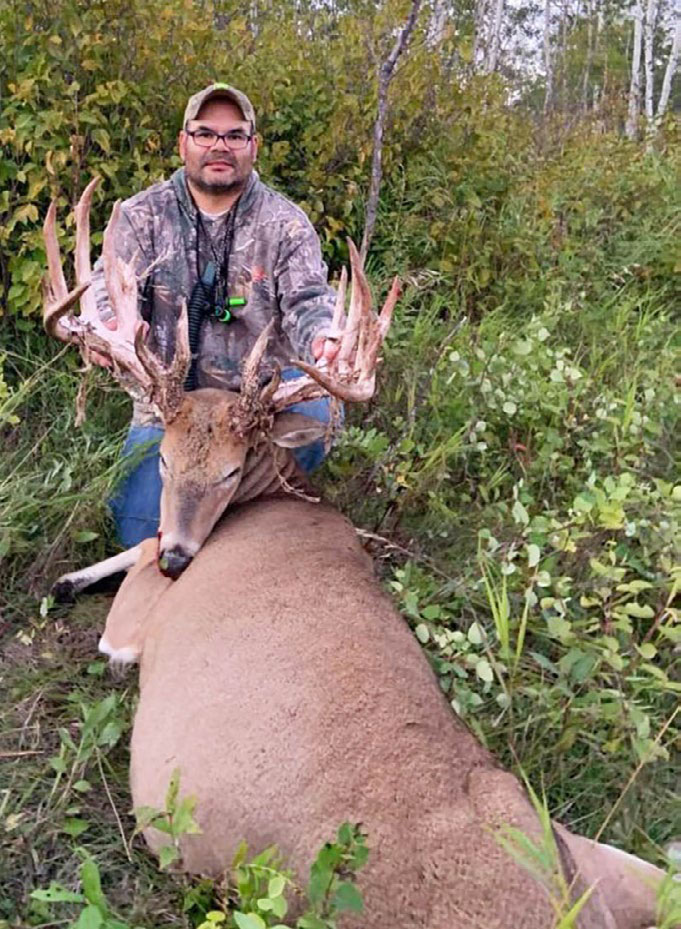- Buck Score: 240 inches
- Date of Harvest: September 7, 2021
- Location of Harvest: Muskowekwan First Nation (Saskatchewan)
- Weapon of Harvest: Ruger American .30-06
Jason Vickert hunts the Muskowekwan First Nation area quite a bit, but he had no idea this massive Whitetail called this area home. He’s lived there for quite a few years and even has a meat shop business close by. But on September 7, 2021, he had an experience he’ll never forget.
After a day’s work, Vickert headed afield with his son and nephew. It was warm, about 15 degrees Celsius, with an overcast sky. The area he was hunting in was a mixture of pasture and timber. It was rough ground and had quad trails weaving throughout it. He hoped to shoot an elk to fill the freezer.
He was walking down one such trail en route to a spot where he’d previously seen some elk sign. About 20 minutes into the still hunt, he reached a slew and started scanning for signs of the magnificent wapiti. Instead, he spotted a couple of does feeding off the edge of the slew. He and the boys observed them for a few minutes.
Moments later, Vickert looked to the right and spotted another deer. He could tell it was a buck but couldn’t determine just how big it was because its head was positioned down, feeding. When it raised up, that motion revealed what it had atop its head. “That’s a big buck, boys,” Vickert said.
He tried to guess the range. Figuring it at 250 yards, he waited for a good shot opportunity. The buck was quartering to him, and he wanted the deer to turn broadside before pulling the trigger. Unfortunately, the does started to spook and that grabbed the buck’s attention. Vickert was afraid the buck might bolt so he settled in and readied for the shot. “I think I’m going to take him, boys,” he said.
The blast rang out, the bullet struck it low, and the deer took off. It ran about 30 to 40 yards into some willows. A few seconds later, it entered a shooting lane and Vickert shot again. That shot struck the deer, which slowed it to a walk. He sent a third shot downrange and the monster buck fell.
Despite seeing it fall, he decided to give the deer some time. He went to scout closer to where he’d seen the elk sign and wanted to show the boys all the rubs the big bull had left on the landscape. When they arrived, they spotted the big elk, but it wouldn’t step into the clearing for a shot. Vickert tried cow calling, but it wouldn’t budge. He believes it was alerted by the gunshots and wouldn’t come out. Since it was getting dark, they decided to head back and recover the Whitetail. At this point, Vickert still didn’t realize just how big this deer was. But when they walked up to it, reality began to set in. This deer was ginormous.
After admiring the deer, they took some photos and reflected on the hunt. Then, they went and got a deer processing kit, quartered up the deer and started the trek out of the backcountry. It was late once they finished and got back home. Once there, they hung up the meat and continued to recount the adventure they’d just had.
“That was a big buck,” Vickert said. “I didn’t want to get overly excited. I’ve shot at some big bucks and missed them. I was in shock. I told the boys this never happens.”
But it did that day— and it produced a 240-inch buck on Muskowekwan First Nation land.
Outdoor Lab: Big Buck Tactics
As with any deer hunt, this one had several takeaways. In an age where most big-buck deer hunters are sitting in pre-hung treestands and hard-sided box blinds, Vickert went a different route. He focused on still-hunting. This is a higher-risk but also a higher-reward tactic. It increases the odds of being detected by deer. Done correctly, it also increases the odds of seeing and getting a shot at a deer, too. That’s what happened on this hunt. Vickert might not have shot this Whitetail if he’d chosen to hunt from a stationary position.
Another takeaway is that Vickert took follow-up shots. Often, hunters take one shot and watch as the deer runs off. Many hunters have lost deer because of this. Sometimes, the first shot is either a miss (and can look like a hit), a bad shot that isn’t lethal, or a bad shot that is lethal but takes a long time to kill the animal, resulting in an unrecovered deer. Because of this, it’s crucial to take follow-up shots as needed. Remember to keep taking responsible shots until the animal is either down or out of sight.

